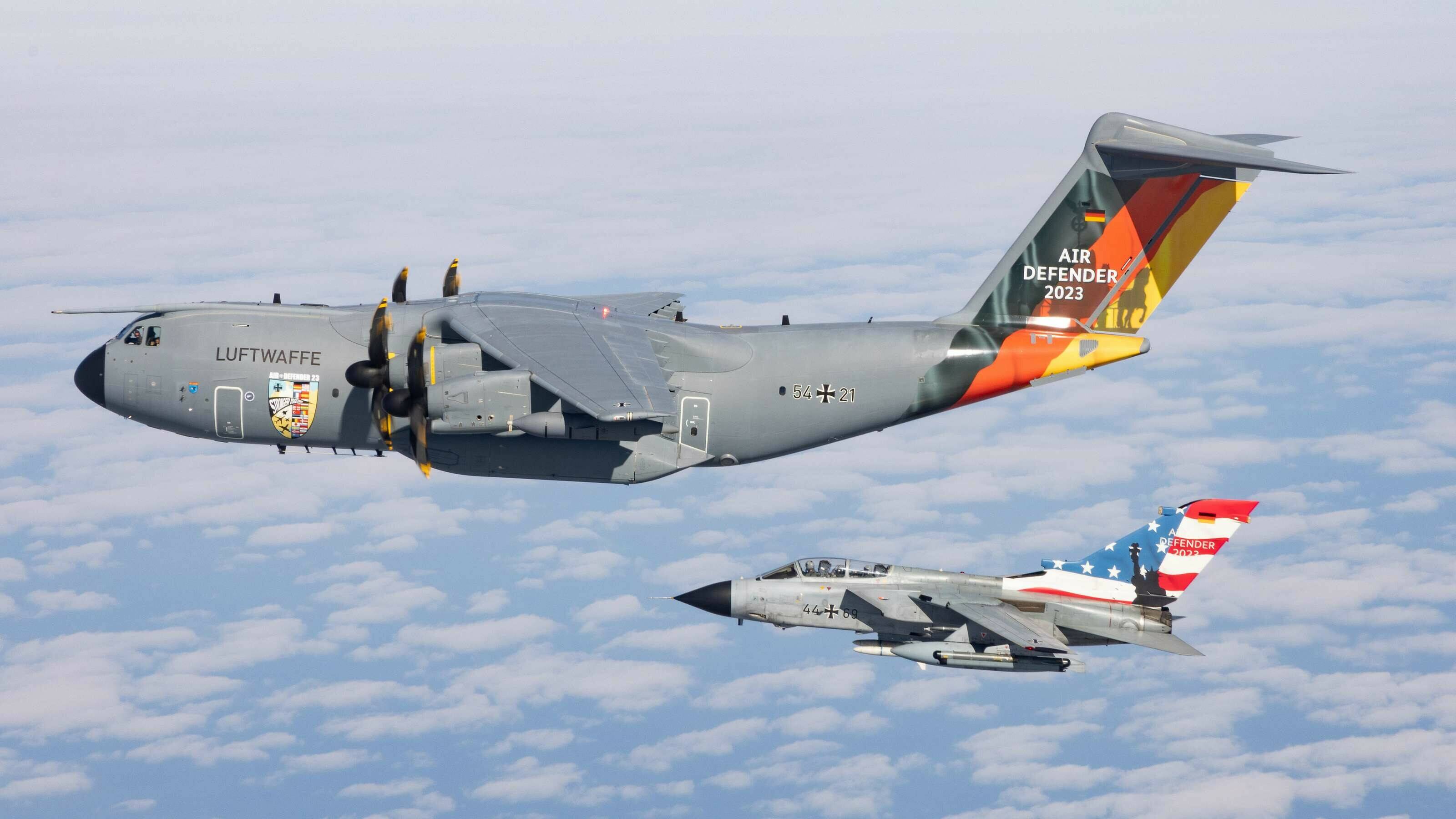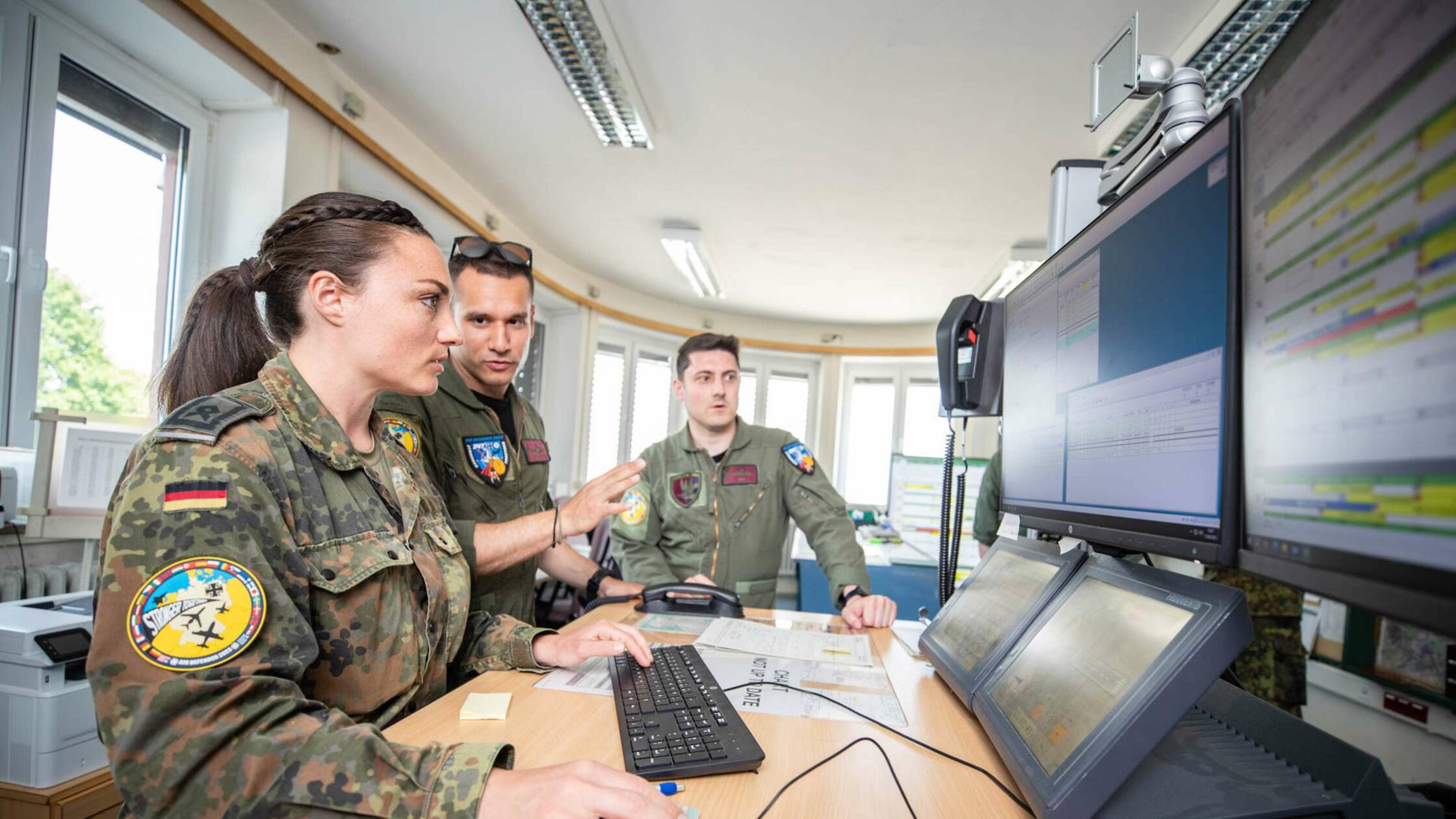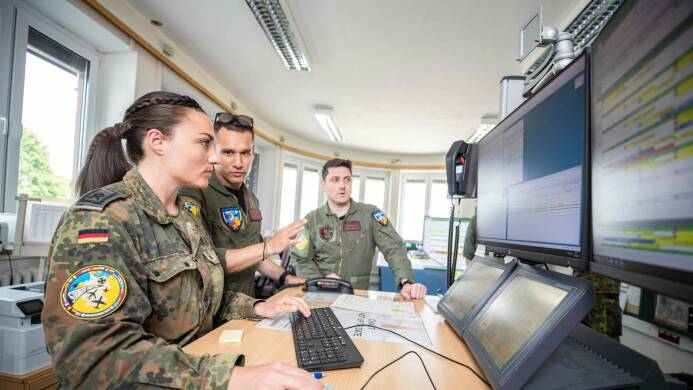Image Credit: Bundeswehr/Christian Timmig
Airspace Article




At the same EUROCONTROL summit, CANSO’s Director General, Simon Hocquard, suggested that there are some key principles to guide improved civil-military cooperation and the flexible use of airspace:
Planning and procedures: Clear guidelines can help planning activities and ensure successful implementation, especially during times of crises.
Cooperation: This needs to occur at the tactical and strategic level. And though the aim is the efficient, flexible use of airspace, it must always consider every aspect of air services, such as joint procurement of new technologies.
Consistency: Agreed procedures need to follow the same standards and language so there is no room for error.
Communication: This is not merely talking to each other but, crucially, sharing information and data.
Trust: If the military insists it needs the airspace, then civil air services must trust them. The reverse is also true. Without trust, the concept of flexible use of airspace fails.
“Air Defender used all these principles and has been a remarkable exercise,” said Hocquard. “The question now is how do we bring them into the real world?”
The EUROCONTROL Summit touched on several factors that will provide the foundation for the successful introduction of these principles. One is airspace design. In essence, airspace is still structured to the needs of older technologies and procedures. Revamping design will naturally increase airspace efficiency and flexibility.
This requires air navigation service providers to invest in the tools necessary for flexible airspace, including training. Modelling and monitoring tools must be in place to determine that optimum efficiency is being met.
Other factors include the correct governance to oversee joint plans and delivery. Again, objectives must be established to know whether plans are working in practice.
The overriding message, however, is that airspace is a common resource that must be allocated to civil or military traffic according to need. The flexible use of airspace will allow efficient traffic flows and effective military missions. That necessitates ongoing commitment, support and engagement from both sides.
“Civil-military cooperation is something we can do now,” concludes Hocquard. “But there must be a willingness to collaborate and share airspace resources, a willingness to adapt longstanding procedures and plan differently and a willingness to share information.
“But the pay-off of that willingness is significant.”
Principles of cooperation

There is no single global story on civil-military cooperation and a number of different models exists ranging from co-location of civil and military operations with a high degree of integration to almost complete segregation. There isn’t a distinguished history to draw on either. Broadly speaking, maintaining existing reserved portions of airspace has been more important than flexibility for both sides, fanning the flames of protectionist thinking.
Indeed, segregation is still the biggest problem. In many countries, military needs take precedence. This doesn’t just affect flights in the country concerned but can have a ripple effect, altering flight patterns and airspace availability in neighbouring nations and even on a regional level. In southeast and east Asia, for example, air traffic initiatives routinely limit commercial flights into mainland Asia. These restrictions get passed through adjacent flight information regions until the entire system experiences delays.
Where the flexible use of airspace does exist, inconsistent implementation is limiting the potential benefits of the concept. A reserved area of airspace might be temporarily released for civil air traffic but, for various reasons, including flight planning, flights do not use it.
And then there is also the challenge of resources, not only in terms of technologies but also personnel. Where cooperation does happen, it is often on an ad-hoc basis, highlighting the need for investment in specialists in civil-military cooperation.
For some, an integrated civil-military ANSP is the best way forward for seamless coordination and collaboration. This has many advantages, including the real-time sharing of data and aeronautical information, resource optimisation and enhanced situational awareness. Moreover, combining facilities, equipment, and personnel can reduce costs and coordinated investment.
Nevertheless, some countries will prefer to maintain separate civil and military ATM capabilities, which can be just as effective with the right mechanisms in place.
All such challenges must be overcome. The ambition of aviation – including net zero carbon emissions, the integration of drones and increasing space travel – makes the case for cooperation compelling. It is no longer sustainable to enforce detours around restricted airspace, for example, lengthening flight times and increasing fuel burn and emissions.
At a EUROCONTROL summit on the subject, Raúl Medina, Director General said: “We need to factor in the needs of civil and military into tomorrow’s planning. There are critical challenges ahead that will require the strongest possible military-civil cooperation.”
Medina also noted that geopolitical tensions and civil air traffic are both increasing, meaning that acting as competitors for a single resource – airspace – is no longer viable.
Flexibility challenges
In June in Europe, 25 nations took part in NATO’s two-week-long Air Defender exercise. The military endeavour involved some 10,000 personnel and 250 aircraft, primarily flying missions over the North Sea, the Baltic Sea and Southern Germany.
Work between stakeholders on Air Defender started well in advance with simulations looking at potential consequences for civil air traffic. Overall, the impact was minimal, according to EUROCONTROL’s Network Manager. It estimates 20,000-25,000 minutes of delays per day due to Air Defender compared, for example, with 100,000 minutes when there is a day of industrial action.
Nevertheless, the scale of the exercise has highlighted the need for civil-military cooperation and greater flexibility in airspace use.
Civil aviation communications, navigation and surveillance (CNS) infrastructure is not always compatible with military aircraft. The transformation of CNS is therefore essential to civil-military cooperation and the flexible use of airspace.
“Achieving civil-military interoperability is hugely important for the network, and vital for our safety in terms of facilitating military mission effectiveness across Europe at a time of war,” says Raúl Medina, Director General, EUROCONTROL. “I strongly believe the time has come to develop a dual-use future CNS infrastructure capable of meeting the needs of all airspace users – civil and military – delivering flight efficiency and helping achieve aviation’s challenging sustainability objectives. This calls for pragmatic industrial research initiatives, and close cooperation between key actors.”
Communications, navigation and surveillance



Read full article



Civil aviation communications, navigation and surveillance (CNS) infrastructure is not always compatible with military aircraft. The transformation of CNS is therefore essential to civil-military cooperation and the flexible use of airspace.
“Achieving civil-military interoperability is hugely important for the network, and vital for our safety in terms of facilitating military mission effectiveness across Europe at a time of war,” says Raúl Medina, Director General, EUROCONTROL. “I strongly believe the time has come to develop a dual-use future CNS infrastructure capable of meeting the needs of all airspace users – civil and military – delivering flight efficiency and helping achieve aviation’s challenging sustainability objectives. This calls for pragmatic industrial research initiatives, and close cooperation between key actors.”
Communications, navigation and surveillance
There is no single global story on civil-military cooperation and a number of different models exists ranging from co-location of civil and military operations with a high degree of integration to almost complete segregation. There isn’t a distinguished history to draw on either. Broadly speaking, maintaining existing reserved portions of airspace has been more important than flexibility for both sides, fanning the flames of protectionist thinking.
Indeed, segregation is still the biggest problem. In many countries, military needs take precedence. This doesn’t just affect flights in the country concerned but can have a ripple effect, altering flight patterns and airspace availability in neighbouring nations and even on a regional level. In southeast and east Asia, for example, air traffic initiatives routinely limit commercial flights into mainland Asia. These restrictions get passed through adjacent flight information regions until the entire system experiences delays.
Where the flexible use of airspace does exist, inconsistent implementation is limiting the potential benefits of the concept. A reserved area of airspace might be temporarily released for civil air traffic but, for various reasons, including flight planning, flights do not use it.
And then there is also the challenge of resources, not only in terms of technologies but also personnel. Where cooperation does happen, it is often on an ad-hoc basis, highlighting the need for investment in specialists in civil-military cooperation.
For some, an integrated civil-military ANSP is the best way forward for seamless coordination and collaboration. This has many advantages, including the real-time sharing of data and aeronautical information, resource optimisation and enhanced situational awareness. Moreover, combining facilities, equipment, and personnel can reduce costs and coordinated investment.
Nevertheless, some countries will prefer to maintain separate civil and military ATM capabilities, which can be just as effective with the right mechanisms in place.
All such challenges must be overcome. The ambition of aviation – including net zero carbon emissions, the integration of drones and increasing space travel – makes the case for cooperation compelling. It is no longer sustainable to enforce detours around restricted airspace, for example, lengthening flight times and increasing fuel burn and emissions.
At a EUROCONTROL summit on the subject, Raúl Medina, Director General said: “We need to factor in the needs of civil and military into tomorrow’s planning. There are critical challenges ahead that will require the strongest possible military-civil cooperation.”
Medina also noted that geopolitical tensions and civil air traffic are both increasing, meaning that acting as competitors for a single resource – airspace – is no longer viable.
Flexibility challenges

At the same EUROCONTROL summit, CANSO’s Director General, Simon Hocquard, suggested that there are some key principles to guide improved civil-military cooperation and the flexible use of airspace:
Planning and procedures: Clear guidelines can help planning activities and ensure successful implementation, especially during times of crises.
Cooperation: This needs to occur at the tactical and strategic level. And though the aim is the efficient, flexible use of airspace, it must always consider every aspect of air services, such as joint procurement of new technologies.
Consistency: Agreed procedures need to follow the same standards and language so there is no room for error.
Communication: This is not merely talking to each other but, crucially, sharing information and data.
Trust: If the military insists it needs the airspace, then civil air services must trust them. The reverse is also true. Without trust, the concept of flexible use of airspace fails.
“Air Defender used all these principles and has been a remarkable exercise,” said Hocquard. “The question now is how do we bring them into the real world?”
The EUROCONTROL Summit touched on several factors that will provide the foundation for the successful introduction of these principles. One is airspace design. In essence, airspace is still structured to the needs of older technologies and procedures. Revamping design will naturally increase airspace efficiency and flexibility.
This requires air navigation service providers to invest in the tools necessary for flexible airspace, including training. Modelling and monitoring tools must be in place to determine that optimum efficiency is being met.
Other factors include the correct governance to oversee joint plans and delivery. Again, objectives must be established to know whether plans are working in practice.
The overriding message, however, is that airspace is a common resource that must be allocated to civil or military traffic according to need. The flexible use of airspace will allow efficient traffic flows and effective military missions. That necessitates ongoing commitment, support and engagement from both sides.
“Civil-military cooperation is something we can do now,” concludes Hocquard. “But there must be a willingness to collaborate and share airspace resources, a willingness to adapt longstanding procedures and plan differently and a willingness to share information.
“But the pay-off of that willingness is significant.”
Principles of cooperation
Work between stakeholders on Air Defender started well in advance with simulations looking at potential consequences for civil air traffic. Overall, the impact was minimal, according to EUROCONTROL’s Network Manager. It estimates 20,000-25,000 minutes of delays per day due to Air Defender compared, for example, with 100,000 minutes when there is a day of industrial action.
Nevertheless, the scale of the exercise has highlighted the need for civil-military cooperation and greater flexibility in airspace use.
In June in Europe, 25 nations took part in NATO’s two-week-long Air Defender exercise. The military endeavour involved some 10,000 personnel and 250 aircraft, primarily flying missions over the North Sea, the Baltic Sea and Southern Germany.

Airspace Article